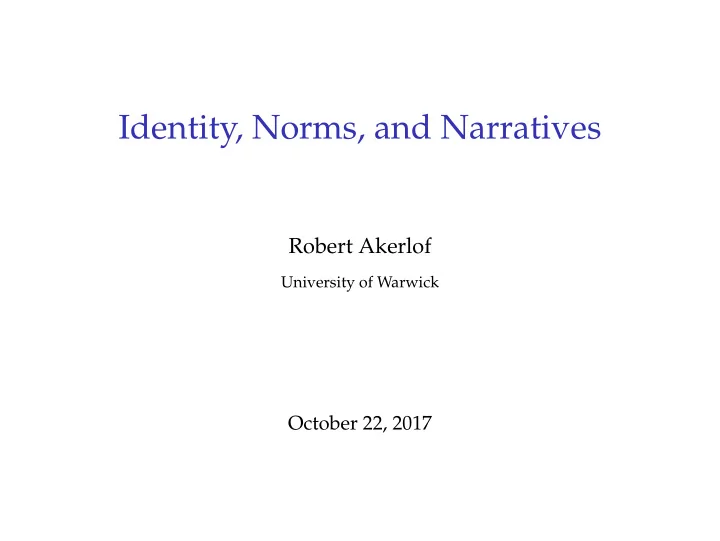

Identity, Norms, and Narratives Robert Akerlof University of Warwick October 22, 2017
Outline 1. The Research Agenda 2. Two Papers ◮ “Value Formation” (GEB, 2017) ◮ “Movers and Shakers” (QJE, 2016) 3. Work-in-progress 1
Research Agenda The main research questions: 1. How are we shaped by social interaction? 2. What are the economic consequences? 2
Research Agenda Importantly, our beliefs are shaped by interaction. ◮ Positive beliefs: what is the world like? ◮ Normative beliefs: what is better/worse? 3
Research Agenda Identity: a package of beliefs. ◮ Who am I? Who are others? ◮ How should someone of my type (others’ types) behave? Narratives: stories that encapsulate beliefs. For instance, ◮ The world is zero-sum. ◮ People get what they deserve (“belief in a just world.”) 4
Research Agenda Beliefs: Demand and Supply ◮ Supply: What am I able to believe? ◮ Information constrains what one is able to believe. ◮ Social interaction affects supply (e.g., the Asch experiment). ◮ Demand: What do I want to believe? ◮ Social interaction also affects demand. 5
Research Agenda Social Network Beliefs Actions 6
Value Formation “Value Formation: The Role of Esteem” (GEB, 2017): Nerds Burnouts 7
Value Formation ◮ Nerds and burnouts have very different values. ◮ What are the determinants of people’s values? How are values shaped by social interaction? 8
Value Formation Values are chosen in the model. Choice motivated by economic considerations, but crucially, also by desire for esteem. Two components of esteem, which result in conflicting desires: ◮ People have desire to be esteemed by peers, which is satisfied by conforming to them. ◮ People have a desire for self-esteem, which is often best satisfied by differentiating. 9
Value Formation Sketch of the Model: Two-player, simultaneous-move game. Players make three choices: (1) Effort at two activities: “academics” and “rock music.” ◮ Achievement at activities depends upon effort and ability. (2) Whether to value achievement at activities. (3) Whether to initiate interaction. ◮ Interaction takes place if either player initiates it. 10
Value Formation Three main assumptions: (1) Basis upon which a player confers esteem depends upon his values. ◮ A player who only values academics (music), confers esteem only on the basis of academic (musical) achievement. (2) Players are esteemed for their relative achievement. (3) Players value self-esteem; when they interact, also value esteem of the other player. 11
Value Formation 8 Player 1 - Musician, Player 2 - Scholar/ No Interaction 6 Both Scholars/ Interaction 4 Α 2 2 Player 1 - Scholar, Player 2 - Musician/ No Interaction Both Musicians/ Interaction 0 0 2 4 6 8 Α 1 Figure 1 12
Value Formation Player 2’s Academic Achievement Player 2's Academic Achievement 12 10 8 6 a 21 4 2 0 0 2 4 6 8 Α 1 Figure 2 13
Value Formation Player 1’s Self Esteem Player 1's Self Esteem 0.80 0.75 0.70 1 E 1 0.65 0.60 0.55 1.15 1.20 1.25 1.30 1.35 Α 1 Figure 3 14
Value Formation Many applications of the model beyond schools, such as: ◮ Inner cities. ◮ William Julius Wilson. ◮ “Acting white.” ◮ Organizational resistance. ◮ Robert Ramsay: the merchant marines. 15
Movers and Shakers “Movers and Shakers” with Richard Holden (QJE, 2016): ◮ Are there economic returns to being socially connected? What are the sources? ◮ Key idea: many economic projects require coordinating parties, getting them to participate. 16
Movers and Shakers An Example: William Zeckendorf 17
Movers and Shakers Place Ville Marie 18
Work-in-progress 1. Group identity U( γ ) γ (group size) 1 2. Family narratives (with Paul Collier and Luis Rayo) ◮ The “protector narrative.” 19
Thank You! 20
Recommend
More recommend